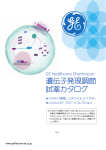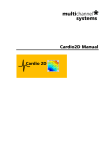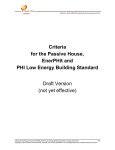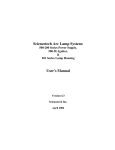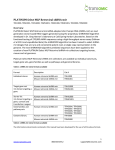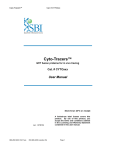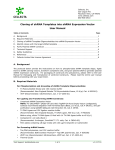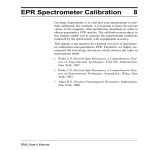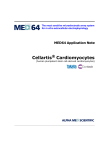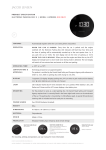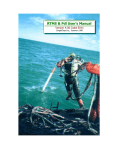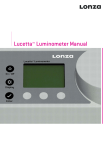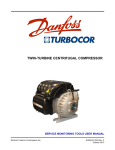Download Cor.4U® Cardiomyocytes
Transcript
Handling Guide: Cor.4U® Cardiomyocytes on the CardioExcyte96® (Nanion Technologies) 1 of 1 TABLE OF CONTENTS 1. GENERAL INFORMATION........................................................................1 2. SAFETY INFORMATION...........................................................................1 3. MATERIAL.................................................................................................2 3.1 CELLS AND MEDIA............................................................................................. 2 3.2 REQUIREMENTS.................................................................................................3 3.3 CARDIOEXCYTE96® INSTRUMENT....................................................................... 3 4. HANDLING OF FRESH COR.4U® CARDIOMYOCYTES DELIVERED IN THE NSP-96 PLATE......................................................................................4 5. PREPARATIONS (FOR CRYOPRESERVED COR.4U® CARDIOMYOCYTES).................................................................................... 4 5.1 COATING OF THE CARDIOEXCYTE96® SENSOR PLATE (NSP-96).......................... 4 6. THAWING AND SEEDING OF COR.4U® CARDIOMYOCYTES............... 5 6.1 THAWING OF CRYOPRESERVED COR.4U® CARDIOMYOCYTES................................5 6.2 COUNTING OF COR.4U® CARDIOMYOCYTES WITH A NEUBAUER HEMOCYTOMETER.. 5 7. INSTRUMENT SETUP..............................................................................7 7.1 EDITING THE INSTRUMENT SOFTWARE.................................................................. 7 8. CELL MAINTENANCE...............................................................................8 8.1 MAINTENANCE OF THE COR.4U® CARDIOMYOCYTES IN THE NSP-96...................8 8.2 MEDIUM CHANGE (COR.4U® CULTURE / BMCC MEDIUM)................................... 9 8.3 COMPOUND TREATMENT.................................................................................... 9 8.3.1%Short%term%protocol%(24%h%treatment)% 8.3.2%Washout%of%Compounds%(Optional)% 11% 8.3.3%LongAterm%protocol% 11% 9% 9. APPENDIX I.............................................................................................13 9.1 RECOMMENDED SEEDING DENSITIES..................................................................13 9.2 EXAMPLE OF A TEST PLATE LAYOUT..................................................................13 10. APPENDIX 2: AXIOGENESIS LIMITED LABEL USE LICENSE............. 14 CardioExcite v.4 Axiogenesis AG - Nattermannallee 1 - 50829 Cologne - Germany Scientific Support: [email protected] 1 of 14 1. General information This protocol covers thawing, seeding and dissociation of Axiogenesis Cor.4U® cardiomyocytes for use on the CardioExcyte96® (Nanion Technologies, Munich, Germany). The CardioExcyte96® Instrument is used for label-free, real-time detection of the beating behavior of cardiomyocytes. It is recommended to use the cells earliest at day 3 post thaw, as the cells develop a syncytium and are beating synchronically after this time in culture. Please read the entire protocol and the Nanion CardioExcyte96® user manual before you start your experiment.! 2. Safety information Cor.4U® cardiomyocytes are produced through in vitro differentiation of transgenic human induced pluripotent stem cells (iPSC) and puromycin selection of the resulting cardiomyocytes. The iPSC line is generated via the Yamanaka protocol from a human skin fibroblast. The highly pure cardiomyocytes (100% purity) express cardiac-specific proteins, e.g. cardiac alpha-actinin and connexin-43, an indication of the ability for electric coupling of these cells. Patch clamp analyses, as well as multi-electrode array (MEA) recordings, demonstrate the normal electrophysiological properties of these cells. Cor.4U® cardiomyocytes are particularly useful for cell-based in vitro assays in pharmacology, safety, and toxicology. These cells are ideal for electrophysiological applications as well as for high content and high throughput screening applications. • Cor.4U® cardiomyocytes are intended for in vitro research use only. The cells are not intended for diagnostics, therapeutic or clinical use and is not approved for human in vivo applications. • Cor.4U® cardiomyocytes are genetically modified human cells and should be handled according to local directives (Biosafety level 1). Cor.4U® cells can be inactivated by autoclaving at 121°C for 20 minutes. • Cor.4U® cardiomyocytes should be cultured in a sterile environment. It is highly recommended that gloves and lab coats be worn when handling all reagents as some reagents contain chemicals that may be harmful. Please consult the Certificate of Analysis (CoA) and Material Safety Data Sheets (MSDS) for additional safety instructions where applicable. CardioExcyte v.4 Axiogenesis AG - Nattermannallee 1 - 50829 Cologne - Germany Scientific Support: [email protected] 2 of 14 3. Material 3.1 Cells and media Material Container Quantity Contents Storage Shelf life Cor.4U® cardiomyocytes (Ax-B-HC02-4M) Cryo vial 1 4 Million cells Liquid nitrogen See label (max. 1.5 years) fresh viable Cor.4U® cardiomyocytes (Ax-C-HC02-EPL) NSP-96 1 Monolayer 37°C Incubator - 250 ml Frozen -20° C / Refrigerated 4° C See bottle label 250 ml Frozen -20° C / Refrigerated 4° C See bottle label Cor.4U® Culture Medium BMCC Medium (serum-free) Bottle Bottle 1 1 INFO: No puromycin is required for the use of Cor.4U® cardiomyocytes in the CardioExcyte96® Instrument ! INFO: Cor.4U® use in the CardioExcyte96® Instrument is standardized for an instrument calibrated to 470 Ohm. NOTE: Do not expose the vials longer than one minute to room temperature as recrystallization processes might harm the cells. NOTE: Thaw medium overnight at 4°C and avoid excess exposure to light. Once thawed, keep medium at 4°C for up to 4 weeks. CardioExcyte v.4 Axiogenesis AG - Nattermannallee 1 - 50829 Cologne - Germany Scientific Support: [email protected] 3 of 14 NOTE: It is not recommended to store the cells at -80°C. Recrystallization can occur which damages the cells. 3.2 Requirements Item Vendor Cat. No. Inverse microscope various Sterile laminar flow hood various Freezer (-20°C) refrigerator (+4°C) various Liquid nitrogen various 10 µL, 100 µL, 1000 µL and 8-channel Pipette various Pipettor for serological pipettes various CardioExcyte96® Instrument Nanion Technologies 19-1002 CardioExcyte96® Sensor Plate (NSP-96) Nanion Technologies 20-1001 Neubauer Hemocytometer various PBS w/o Ca2+ and Mg2+ various PBS with Ca2+ and Mg2+ various Fibronectin Sigma F1141 Trypan blue solution Sigma T8154 Sterile reservoir various Sterile 50 mL polypropylene tubes various 3.3 CardioExcyte96® Instrument CardioExcyte v.4 Axiogenesis AG - Nattermannallee 1 - 50829 Cologne - Germany Scientific Support: [email protected] 4 of 14 4. Handling of fresh Cor.4U® cardiomyocytes delivered in the NSP-96 plate NOTE: This step is only necessary if fresh Cor.4U® cardiomyocytes seeded in NSP-96 plates were purchased. Exchange the medium and place the NSP-96 plate into the incubator. You can follow the protocol from step 7. 1. Carefully remove the silicon lid. 2. Change medium upon arrival by removing 50 µl of the medium and replace with 100 µl of fresh, warm Cor.4U® Culture Medium. 3. Thereafter remove 100 µl medium and replace again with 100 µl fresh, warm Cor.4U® Culture Medium. Repeat this step 3 times to achieve a complete medium change. 4. Transfer the NSP-96 plate immediately into a humidified incubator. Day 0 5. Preparations (for cryopreserved Cor.4U® cardiomyocytes) 5.1 Coating of the CardioExcyte96® Sensor Plate (NSP-96) 1. Prepare 6 ml fibronectin coating solution by diluting 60 µl fibronectin stock solution (1 mg/ml) in 6 ml of PBS with Ca2+ and Mg2+. The final concentration of the coating solution is now 10 µg/ml fibronectin (Dilution 1:100). Mix the solution carefully. NOTE: Fibronectin is very susceptible to shear stress. Avoid harsh pipetting and do not vortex or spin the solution. NOTE: Avoid drying of the coating solution to prevent denaturation of the protein. Be careful not to touch the bottom of the wells to avoid damage of the coating. CardioExcyte v.4 Axiogenesis AG - Nattermannallee 1 - 50829 Cologne - Germany Scientific Support: [email protected] 5 of 14 2. Transfer the coating solution into a sterile reservoir suitable for an 8-channel pipette. Pipette 50 µl of the coating solution into each well of the NSP-96 using an 8-channel pipette and incubate for 1.5h at 37°C. Alternatively, you can incubate the coating solution at 4°C overnight. NOTE: Use a CardioExcyte96® Sensor Plate (NSP-96), the only suitable format for use in the CardioExcyte96® Instrument. 6. Thawing and seeding of Cor.4U® cardiomyocytes 6.1 Thawing of cryopreserved Cor.4U® cardiomyocytes 1. Transfer 3 ml Cor.4U® Culture Medium into a 50 ml tube (tube A) and warm to 37°C. 2. Before thawing the cells, warm 1 ml Cor.4U® Culture Medium in another 50 ml tube (tube B). 3. Quickly transfer the cells from liquid nitrogen on dry ice directly to a 37°C water bath and thaw the vial until the frozen cell suspension detaches from the bottom of the vial and only a small ice clump is visible (approx. 2 min). 4. Disinfect and transfer the vial to the laminar flow hood and pipette the cell suspension drop-wise carefully into the tube containing 3 ml Cor.4U® Culture Medium (tube A). 5. Rinse the vial with 1 ml Cor.4U® Culture Medium from tube B and transfer drop-wise to tube A. The total volume in tube A is now 5 ml. NOTE: Do not spin down the cell suspension! Centrifugation directly after thawing will damage the cells and leads to cell loss. 6.2 Counting of Cor.4U® cardiomyocytes with a Neubauer hemocytometer 1. Add 20 µl trypan blue solution to the 20 µl of the cell suspension in a tube. 2. Apply 10 µl of the 1:1 mixture into a Neubauer hemocytometer and count viable (clear), dead (blue) and total cells. CardioExcyte v.4 Axiogenesis AG - Nattermannallee 1 - 50829 Cologne - Germany Scientific Support: [email protected] 6 of 14 NOTE: Do not move the plate directly after seeding to avoid uneven distribution of the cells. 3. Count the number of cells in each of the four outer boxes highlighted in yellow of Figure 2. Calculate the mean number of cells per yellow box. Fig. 1 Neubauer hemocytometer 4. Calculate the number of cells corrected by chamber factor (1 x 104), dilution factor (2), and total volume (5 ml) E.g.: Mean number of cells per box = 50 50 x 10000 x 2 x 5 = 5,000,000 (5 million cells in the cell suspension) NOTE: When using an automated cell counter, please count at least once with a Neubauer hemocytometer. 5. The recommended standard seeding density of Cor.4U® cardiomyocytes for the CardioExcyte96® Instrument is 3 x 104 cells per well in 200 µl of medium. Adjust the cell suspension to at least 2.88 x 106 viable cells in 19.20 ml of Cor. 4U® Culture Medium. 6. Mix the cell suspension carefully, and transfer it into a suitable container, e.g. a sterile reagent reservoir. 7. Aspirate the fibronectin from the wells of the NSP-96 and immediately add 200 µl of the cell suspension to each well of the plate. CardioExcyte v.4 Axiogenesis AG - Nattermannallee 1 - 50829 Cologne - Germany Scientific Support: [email protected] 7 of 14 NOTE: To receive an even distribution of the cells/well, shake the reagent reservoir after applying the cell suspension to at least every third row of the NSP-96 in order to avoid the cells settling down to the bottom of the reagent reservoir. 8. After adding the cell suspension, do not move the plate. Let it stand in the laminar flow hood at room temperature for 30 min before transferring it into the CardioExcyte96® Instrument in the incubator. 7. Instrument setup 7.1 Editing the instrument software INFO: When purchasing fresh Cor.4U® cardiomyocytes, a USB stick with experimental setup and previous measurements is provided. This data can be used as a basis for further measurements. 1. Open the CardioExcyte® software and click on the “EDIT” icon to select the sweep duration, number of sweeps and repetition interval. Choose the impedance mode for Cor.4U® cardiomyocyte impedance measurements or the EFP mode for extracellular field potential recordings. NOTE: Please read the CardioExcyte96 manual regarding settings for the measurement. 2. Click on the “EDIT COMPOUNDS” icon and generate your compound – and Solution-layout. 3. Click on the “START MEASUREMENT” icon. A little window will pop up to define the chip number of the CardioExcyte96® Sensor Plate and the name of your experiment. CardioExcyte v.4 Axiogenesis AG - Nattermannallee 1 - 50829 Cologne - Germany Scientific Support: [email protected] 8 of 14 Day 1- Day 2 8. Cell maintenance 8.1 Maintenance of the Cor.4U® cardiomyocytes in the NSP-96 1. Exchange the entire culture medium twice, approx.18h (morning) and 26h (evening) after seeding. As long cultivating the Cor.4U® cardiomyocytes in Cor. 4U® Culture Medium, a medium change twice per day is necessary. 2. Warm at least 42 ml of Cor.4U® Culture Medium to 37°C. Immediately before use, transfer the warm medium into a suitable container, e.g. a sterile reagent reservoir. 3. Pause the CardioExcyte96® Instrument monitoring by clicking the “ADD COMPOUND” icon in the CardioExcyte96® software. Choose your SolutionLayout (e.g plate A for medium exchange with Cor.4U® Culture Medium) Disengage the NSP-96 from the CardioExcyte96® Station and transfer it to the laminar flow hood. 4. Perform a 100% medium replacement in four steps. Remove 100 µl of the medium from every well and add the same amount of fresh medium to each well. Repeat this step 4 times. NOTE: Remove medium carefully from the top, avoid touching the bottom of the plate with the pipette tips. Use a slow speed when pipetting up and down. 5. Place the NSP-96 plate back into the CardioExcyte96® Station as quickly as possible and resume the measurement by clicking the “PROCEED WITH STANDARD MEASUREMENT” icon. INFO: In order to prevent putative temperature effects when handling the NSP-96 plate in the laminar flow hood, unplug the CardioExcyte96® device and put the complete system containing the NSP-96 in the laminar flow hood. Hence, the temperature of the NSP-96 plate is passively stabilized. The lid of the plate can be lifted despite the NSP-96 plate being in the device. After re-plugging the device, the START/ CONTINUE icon will be active again. CardioExcyte v.4 Axiogenesis AG - Nattermannallee 1 - 50829 Cologne - Germany Scientific Support: [email protected] 9 of 14 Day 3! 8.2 Medium change (Cor.4U® Culture / BMCC medium) 1. Optional, you can switch from Cor.4U® Culture Medium to serum-free BMCC Medium that is more appropriate for compound testing. 2. Warm at least 42 ml BMCC Medium to 37°C. 3. Perform the medium change as described above for day 1-2. 4. As soon cultivating the Cor.4U® cardiomyocytes in BMCC Medium, exchange medium twice at day 1, afterwards, medium exchange is necessary only once per day (once a stable and regular BR/AMP is detectable) due to a reduced metabolism of the cells in this medium. INFO: Due to the different medium composition, a drop in the total Base Impedance value will occur after changing to serum-free BMCC medium. 5. Repeat the 100% medium change for every culture day until you perform a compound treatment. 6. As soon a stable baseline beating can be monitored you can start with the compound treatment. Day 4 8.3 Compound Treatment 8.3.1 Short term protocol (24 h treatment) The first contraction signal of Cor.4U® cardiomyocytes can be detected approx. 24 h after plating. The beating frequency might be high due to incomplete coupling of the Cor.4U® cardiomyocytes. As soon as a stable baseline beating can be monitored (approx. 72 h after plating), the cells can be treated with test compounds. CardioExcyte v.4 Axiogenesis AG - Nattermannallee 1 - 50829 Cologne - Germany Scientific Support: [email protected] 10 of 14 We recommend checking the following quality criteria before starting a compound treatment:! QC Criteria Cor.4U® cardiomyocytes Basal Impedance Beating Rate Amplitude > 320 Ohm 40 – 100 bpm > 2 Ohm 1. Perform a 100% medium change approx. 2 h before adding the compounds as described above. 2. Prepare at least 120 µl per well of double-concentrated compound dilutions in the designated medium. Prepare the compound solutions in a 96-deep well plate (preferentially with an U-shaped bottom following exactly the defined layout. An example for a plate layout can be found in the appendix. 3. Equilibrate all compound solutions in the cell culture incubator for at least 30 min to adjust temperature and pH. INFO: The final concentration of solvent (e.g. DMSO) must not exceed 0.1%. We recommend using at least triplicates for each compound concentration. 4. Perform a reference measurement before you add the compounds by clicking the “ADD COMPOUND” icon. Choose your preferred interval, e.g. every 2 min for 10 min and resume your measurement. 5. Pause the CardioExcyte96® Instrument by clicking the “ADD COMPOUND” icon, choose your compound - Layout and disengage the NSP-96 plate from the station and transfer it to the laminar flow hood, together with the equilibrated compound plate. 6. Remove 100 µl of the medium from the top of each well using an 8-channel pipette and add 100 µl of the equilibrated double-concentrated stock solution, following the layout design. 7. Transfer the NSP-96 plate back into the station as quickly as possible and immediately resume the measurement by continuing with clicking the “PROCEED WITH MEASUREMENT SERIES” icon, e.g with a preferred interval of every 2 min for 60 min. CardioExcyte v.4 Axiogenesis AG - Nattermannallee 1 - 50829 Cologne - Germany Scientific Support: [email protected] 11 of 14 8.3.2 Washout of Compounds (Optional)! INFO: After the measurements are finalized (e.g. 24 h after compound addition), a washout step can be performed. 1. Warm 42 ml of the designated Cor.4U® Culture Medium without compounds to 37°C. 2. Pause the CardioExcyte96® Instrument, disengage the NSP-96 plate from the station and transfer it to the laminar flow hood. 3. Remove 100 µl from every well and add 100 µl of fresh Cor.4U® Culture Medium to each well using an 8-channel pipette. Repeat this medium exchange 4 times. NOTE: When using several compounds, exchange pipette tips after each run to avoid mixing of the compounds. 4. Return the NSP-96 plate back into the CardioExcyte96® station as quickly as possible and resume the measurement for additional 2 h - 12 h. 8.3.3 Long-term protocol NOTE: For compounds with an anticipated long-term effect, the treatment protocol can be extended to at least 72 hours. 1. Exchange the compound solution with fresh, 1x concentrated compound solution once per day. The first medium change should be performed after the 24 h measurement. 2. Prepare 1x concentrated compound dilutions in the designated medium and equilibrate all compound solutions in the cell culture incubator for at least 30 min to adjust temperature and pH. CardioExcyte v.4 Axiogenesis AG - Nattermannallee 1 - 50829 Cologne - Germany Scientific Support: [email protected] 12 of 14 3. Every 24 hours, pause the CardioExcyte96® Instrument, disengage the NSP-96 plate from the CardioExcyte96® Station and transfer it to the laminar flow hood. 4. Cells in BMCC Medium: Remove 100 µl of the compound solution from the top of each well, and replace it with 100 µl of the freshly prepared compound solution. 5. Cells in Cor.4U® Culture Medium: Remove 100 µl of the compound solution from the top of each well, and replace it with 100 µl of the freshly prepared compound solution, repeat this step 3 times. 6. Transfer the NSP-96 plate back into the station as quickly as possible and resume the measurement. 7. Repeat this step every 24 h. 8. After the last measurement is finished, perform a washout step as described above. CardioExcyte v.4 Axiogenesis AG - Nattermannallee 1 - 50829 Cologne - Germany Scientific Support: [email protected] 13 of 14 9. Appendix I 9.1 Recommended seeding densities The recommended standard seeding density of Cor.4U® cardiomyocytes for the CardioExcyte96® Instrument is 3 x 104 cells per well in 200 µl of medium. However, depending on the experimental needs, the seeding density can be modified. 9.2 Example of a Test Plate layout Figure 2: Each color represents one test compound. Vehicle controls (e.g. DMSO) as well as standard controls (e.g. Isoproterenol and E-4031) are included. We recommend starting with compounds with well-known effects on cardiomyocytes, e.g. E-4031, Isoproterenol, Nifedipine, etc. CardioExcyte v.4 Axiogenesis AG - Nattermannallee 1 - 50829 Cologne - Germany Scientific Support: [email protected] 14 of 14 10. Appendix 2: Axiogenesis Limited Label Use License A. AXIOGENESIS Intellectual Property Rights This product is covered by patent families including, but not limited to, EP1348019; EP1002080; EP1745144; EP1644485; JP4904153; JP4159358; JP3956154; JP4814875; DE10136702 and other families of patent applications (“AXIOGENESIS Intellectual Property”). Purchase of the product does not transfer any rights other than those outlined below. The purchase of this product conveys to the buyer the non‐exclusive, non‐ transferable right to use the purchased amount of Cor.4U® cells and the associated AXIOGENESIS Intellectual Property for (i) for non-profit internal research conducted by the buyer and (ii) certain for‐profit activities, including lead discovery, testing and/or research and development of other products. The use in disease modeling and tissue modeling is expressly excluded in this license. Please contact Axiogenesis for a license for disease and tissue Models at [email protected]. B. Use Restrictions This product is not suitable for any clinical, therapeutic (including cell therapy, transplantation, and regenerative medicine), or clinical diagnostic applications. The purchaser shall not use the product in any way that contravenes applicable laws or regulations. The product should be used according to the User Guide. Failure to comply with any provisions in section A, B, or C will make any warranty claims invalid. No rights are conveyed to modify, reproduce, or clone any part of this product or to use AXIOGENESIS Intellectual Property in any way that is separate from the purchased product. C. Other Patents AXIOGENESIS products which were derived from iPS cells are covered by patents in patent family EP1970446 and US8048999 licensed from iPS Academia (Kyoto University). Additionally, GFP and RFP positive products are covered by patents owned by Evrogen. The GFP and RFP positive products are for internal, non‐commercial research use only. The right to use a GFP positive product specifically excludes the right to validate or screen compounds. For information on commercial licensing, contact the Evrogen Licensing Department at: [email protected]. Cor.At® and Cor.4U® are registered trademarks of AXIOGENESIS AG, Cologne, Germany. Mel.Cor is a trademark of AXIOGENESIS AG, Cologne, Germany. TurboGFP and TurboRFP are trademarks of Evrogen, Moscow, Russia. Peri.4UTM, Dopa.4UTM, CNS.4UTM and Astro.4UTM neural cells are trademarks of AXIOGENESIS AG, Cologne, Germany. For information on the patents, patent applications, and licenses associated with the product contact the AXIOGENESIS Business Development Department, AXIOGENESIS AG at: [email protected]. CardioExcyte v.4 Axiogenesis AG - Nattermannallee 1 - 50829 Cologne - Germany Scientific Support: [email protected]
















